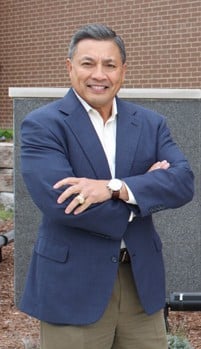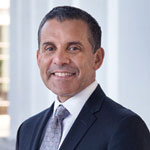
Before A.B. Cruz III had ever heard of Emergent BioSolutions Inc., he received a full dose of the pharmaceutical company’s premier product: BioThrax, the only anthrax vaccine used by the US government. “When the threat assessment came through, and among the threats was anthrax,” says the retired US Navy admiral, “the order came down that we were required to be vaccinated, so I got in line.”
Today, as Emergent’s executive vice president and general counsel, Cruz is no longer a patient; he’s helping grow Emergent as well as the prominence of BioThrax. When he joined the company in December 2013, Cruz was new to the pharmaceutical industry but was attracted to the company for a number of reasons. He saw Emergent’s mission, “to protect and enhance life,” as an extension of his career in military service. He also gravitated to Emergent’s rapidly growing profile.
Since its founding in 1998, Emergent has grown both organically and through a series of strategic acquisitions. Cruz points to two key deals completed recently: In early 2013, the company expanded its biodefense offerings by acquiring Bracco Diagnostics Inc.’s health-care protective products division, which produces RSDL, a decontamination lotion that removes and neutralizes chemical warfare agents. And in 2014, Emergent closed on its biggest acquisition, that of Canadian-based Cangene, which specializes in therapeutics with applications in biodefense, transplantation, oncology, and hematology.
The Cangene purchase was instrumental for several reasons: it increased Emergent’s workforce and expanded its global footprint. Emergent’s revenue-generating products expanded significantly, up to nine from two. Perhaps most importantly, it moved the company further towards its goal of penetrating the commercial market, rather than serving ostensibly as a government supplier.
Indeed, one of the realities faced by government contractors, according to Cruz, is the shifting whims of federal funding. “While the US government is currently committed to biodefense and preparedness efforts,” he says, “sequestration and scarcity of funding is always a possibility in the industry.” In its efforts to grow, Emergent must also grapple with the highly competitive pharmaceutical industry. According to Cruz, Emergent distinguishes itself from its competitors by focusing on developing and acquiring late-stage development products as opposed to those in the high-risk/high-reward area of early-stage development. Emergent also tailors its portfolio by focusing on the areas of oncology and hematology.
Like many other pharmaceutical companies, Emergent operates in a highly regulated environment. “It has become increasingly complex and very stringent,” says Cruz, citing a litany of examples from the recently passed Sunshine Act, which requires pharmaceutical companies to report payments or other transfers of value given to US physicians, to teaching hospitals, to the Foreign Corrupt Practices Act, and to SEC regulations—not to mention foreign countries’ own rigorous guidelines. “Being a US government contractor, there are further regulations that flow under federal acquisition regulation,” says Cruz. “This is just a sampling. The regulatory regime in the biopharmaceutical industry certainly isn’t trending towards being any less onerous.” Despite hefty regulations, Cruz is confident about Emergent and its representatives’ ability to comply. “We have to make sure that we’re above the line and all of our agents get strict guidelines on what they can or can’t do,” he says.
As part of Cruz’s efforts to expand and shape Emergent, he also steadfastly believes in fostering a diverse workforce along ethnic, racial, and gender lines. One way he plans to achieve this goal is by modifying the guidelines for law firms that support the company to make clear that Emergent’s expectation is that their
attorneys are indeed diverse.
“As a global company, diversity in our workforce is an imperative,” he says. For Cruz, it’s not simply about breaking glass ceilings; it’s about yielding more productive and vetted ideas. “Having a diversity of thoughts leads to better decision making,” he says. “It may take a little longer, but you get more thought-out decisions in the end.”
A Través
de los Años
The critical acquisitions that helped Emergent break into the commercial market
2003: Emergent acquires Antex Biologics.
2005: Emergent adds Microscience, a British vaccine company, to expand its presence into Europe.
2006: Through Vivacs, a German biotech company, Emergent earns a product development footprint in the German market.
2010: Emergent partners with Temasek Life Sciences to develop a broad-spectrum pandemic flu vaccine and therapeutic. In the same year, it acquires Trubion, which gives Emergent potential therapies for cancerous and autoimmune diseases.
2012: Emergent acquires the exclusive right to manufacture and sell VaxInnate’s pandemic influenza vaccine candidate in the United States.
2013: Emergent expands its biodefense product offerings by acquiring a division of Bracco Diagnostics that produces a chemical warfare neutralizing ointment.
Later that year, one of Emergent’s products, Otlertuzumab, shows positive results in combination with other drugs for the treatment of chronic lymphocytic leukemia and other cancers of the blood.
In December Emergent announces acquisition of a Canadian-based company, Cangene, solidifying its position in the biodefense market with three additional US government-procured therapeutics.
2014: In August, Emergent signs a licensing agreement with MorphoSys to codevelop and commercialize ES414, a prostate cancer drug candidate. That same month, the company makes a pact with the US government valued at $18.9 million over three years for a therapeutic created for the treatment of complications due to smallpox vaccination.

